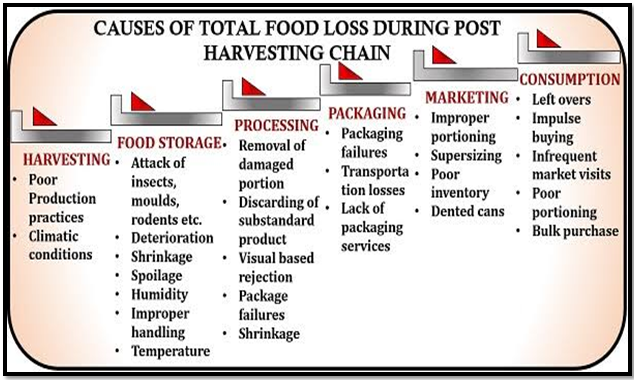CHOOSING THE RIGHT TRACK TO CUT POST-HARVEST LOSSES
Syllabus:
GS 3:
- Transport and Marketing of Agricultural Produce and Issues and Related Constraints.
- Food Processing and Related Industries in India- Scope’ and Significance.
Why in the News?
- The Indian government is focusing on reducing post-harvest losses, especially in perishable goods, to enhance agricultural exports.
- Recent initiatives by the Indian Railways, such as the Kisan Rail and truck-on-train services, aim to improve agri-logistics, support small and marginal farmers, and boost the agricultural supply chain efficiency.
Source: Global giving
India’s Agricultural Export Challenge
- Global Ranking: India ranks second in global agriculture production but holds only 2.4% share in global agricultural exports, ranking eighth worldwide.
- Productivity Issues: Low productivity and an inability to meet desired quality standards contribute to this disparity.
- Supply Chain Inefficiencies: Inadequate transportation networks and infrastructure lead to significant post-harvest losses.
- Financial Impact: Post-harvest losses in India amount to approximately ₹1,52,790 crore annually, according to a 2022 study by the Ministry of Food Processing Industries.
- Population Growth: As India’s population grows, the challenge of meeting food and nutrition demands intensifies.
- Importance of Loss Prevention: Preventing post-harvest losses is crucial in addressing food demand and nutrition challenges.
Post-Harvest Loss Breakdown
- Perishable Commodities: The biggest losses come from perishable items like livestock produce (22%), fruits (19%), and vegetables (18%).
- Export Losses: About 19% of food is lost during the export process, particularly at the import-country stage.
- Critical Role of Logistics: Effective storage, transportation, and marketing are essential for ensuring perishable products reach consumers on time.
- Agri-Logistics Priority: Strengthening agri-logistics is recognized as a priority by the Committee on Doubling Farmer’s Income (DFI).
- Supply Chain Complexity: The supply chain includes multiple logistical requirements, from farmgate to wholesale transportation and last-mile delivery.
- Small and Marginal Farmers: About 86% of Indian farmers are small and marginal, struggling to achieve economies of scale and market connectivity, resulting in post-harvest and income losses.
Food Price Volatility and Rail Transport
- Supply Constraints: Food price volatility in India is partly caused by supply constraints affecting perishable produce.
- Railways Revenue: Indian Railways earns 75% of its revenue from freight transport, including agricultural produce.
- Urban-Rural Connectivity: Indian Railways efficiently connects urban centers and rural areas, crucial for moving agricultural products.
- Food Corporation of India: The organization relies on Indian Railways to move about 90% of its food grains.
- Road Transport Dominance: Approximately 97% of fruits and vegetables are transported by road, not rail.
- Impact on Perishables: Supply constraints and transport inefficiencies significantly impact perishable food items.
Railways Initiatives for Perishables
- Truck-on-Train Service: This service carries loaded trucks on railway wagons, expanding following successful trials.
- Parcel Special Trains: Introduced during the COVID-19 pandemic, these trains transport perishables and seeds between markets and producers.
- Kisan Rail: Launched to connect surplus regions to consumption areas more efficiently, reducing post-harvest losses and enhancing farmer incomes.
- Success Stories: For example, Nashik grape growers earned a net profit of ₹5,000 per quintal using Kisan Rail.
- Awareness and Accessibility: Initiatives must focus on increasing farmer awareness and accessibility to Railway schemes.
- Investment in Infrastructure: Specialized wagons for temperature-controlled transport and rail-side facilities for safe cargo handling are essential.
Challenges and Recommendations
- Multiple Touch Points: Multiple handling points during rail transport of perishables pose challenges, risking spoilage and contamination.
- Food Safety: Investment in specialized infrastructure can enhance food safety by minimizing spoilage and contamination risks.
- Streamlining Processes: Streamlining loading and unloading processes can minimize transit times and improve efficiency.
- Addressing Staffing Shortages: Recruitment and training initiatives are essential to address staffing shortages.
- Railways Over Roadways: Prioritizing railways for transporting fruits and vegetables can lead to more efficient transportation.
- Support for Domestic and Export Markets: Enhanced rail infrastructure supports both domestic and export markets, reducing post-harvest losses.
Untapped Opportunities
- Environmental Impact: Railways generate up to 80% less carbon dioxide for freight traffic than road transport, benefiting the environment.
- Systems-Based Approach: Adopting a systems-based approach across transport modes and geographies is necessary.
- Private Sector Role: Public-private partnerships can enhance operational efficiency and strengthen rail infrastructure.
- Budgetary Support: The agriculture budget for 2024 aims to bridge the farm-to-market gap with modern infrastructure and value-addition support.
- Complementary Efforts: Railway initiatives complement these efforts by supporting efficient transportation of perishable goods.
- Reducing Losses: Efficient rail transport minimizes post-harvest losses, positively impacting livelihoods and the environment.
Conclusion
Addressing post-harvest losses through improved logistics and infrastructure is critical for India’s agricultural sector. By enhancing transportation systems and supporting local farmers, India can reduce food wastage, increase agricultural exports, and ensure food security for its growing population.
Source:The Hindu
Mains Practice Question:
Discuss the impact of post-harvest losses on India’s agricultural economy and the steps taken by the government to mitigate these losses. How can the Indian Railways play a pivotal role in improving the agri-logistics sector?
Associated Article:
https://universalinstitutions.com/category/daily-answer-writing-practice/gs-3/agriculture-gs-3/




